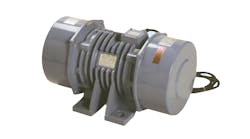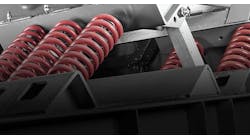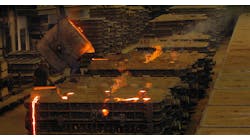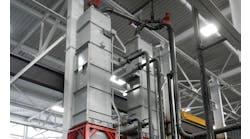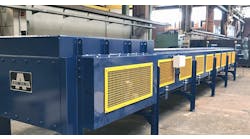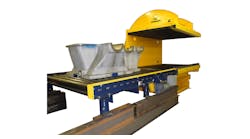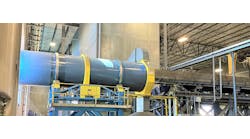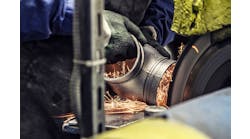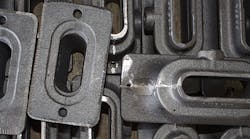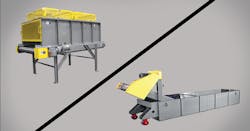For diecasting operations, as well as for other applications producing critical parts, a conveyance system that is safe, efficient, reliable, and able to handle heavy payloads at extreme temperatures while also expediting the cooling process is invaluable. Implementing the wrong conveyor not only presents an immediate danger to workers, but also increases the likelihood of a fire caused by wayward materials coming into contact with flammable substances.
Both quench conveyors and casting coolers are capable of addressing these issues. However, there are several key elements that set these types of units apart. Leading up to an operation’s decision as to which system suits its needs, a proper understanding of the benefits, drawbacks, and features each conveyor presents is critical.
How casting coolers work
Hot parts are loaded onto a slow-moving steel belt conveyor with built-in fans that blow ambient air as the contents pass underneath. With parts entering the conveyor as hot as 1,000°F, sufficient floor space is required to ensure that the payload’s temperature can gradually decrease over an extended period of time.
Often a long footprint is needed for casting coolers to be effective, depending on part throughput and desired drop in temperature.
How quench conveyors work
A conveyor is fitted within a liquid-tight tank that generally is filled with a quench solution. If water is the primary quench, a rust inhibitor is recommended. To ensure that the liquid stays at a given temperature, a chiller coil that collects and cools hot liquid before recirculating it back into the tank is implemented.Depending on the amount of BTUs that the operation requires, a chiller coil can be a potentially substantial investment.Pros and cons
Quench conveyors and casting coolers each have inherent strengths and weaknesses, which are important to consider when making a purchase for your operation. Available space, cost, project timeline, health risks, and potential repairs should all come to mind when you are making a selection between these two.
As mentioned, a casting cooler typically takes up a much larger physical footprint within a plant than a quench conveyor. This is because the conveyors need to move hot parts slowly underneath the fans to cool properly, and a longer distance helps to ensure this process’ success.
Cost
Between the two, quench conveyors usually are more expensive. Between a liquid-tight tank, coil chiller, rust inhibitor, and the conveyor itself, several elements are required. While the outright cost of the unit itself is much cheaper, casting coolers have particular expenses in the form of higher energy bills. This is due to the electricity needed to run the multiple fans included within the unit over long periods of time.
Project timeline
Although more expensive, quench conveyors can offer a faster cooling process for parts handling systems when air cooling is either insufficient or impractical for an operation. When preparing to choose a conveyor, this extra time can mean all the difference when short deadlines need to be met.
Health risks
When water is used in a quench conveyor, misting often occurs. This can cause plant-air quality issues that may impact the health of workers and create the setting for legal sanctions that could negatively impact an operation.
When casting coolers are used instead, the risk of misting is eliminated.
Potential repairs
It should come as no surprise that a casting cooler is more likely to require maintenance than a quench conveyor. Between the fans and the actual conveyor, there are several moving parts that need to be monitored. That is why a vigilant staff and a detailed maintenance plan must be in place if an operation is considering a casting cooler for its needs.
Casting coolers and quench conveyors are both solutions that can safely handle the extreme payloads produced by diecasting and other operations producing critical parts. That being said, these two units are not interchangeable solutions for a one-size-fits-all problem. A manufacturer should consider factors like available space, cost, project timeline, health risks, and potential repairs before deciding between these two conveyance systems.
Bob Anspaugh is a Conveyor Sales Engineer for PRAB Inc., Kalamazoo, MI. Contact him at [email protected], or visit www.prab.com

